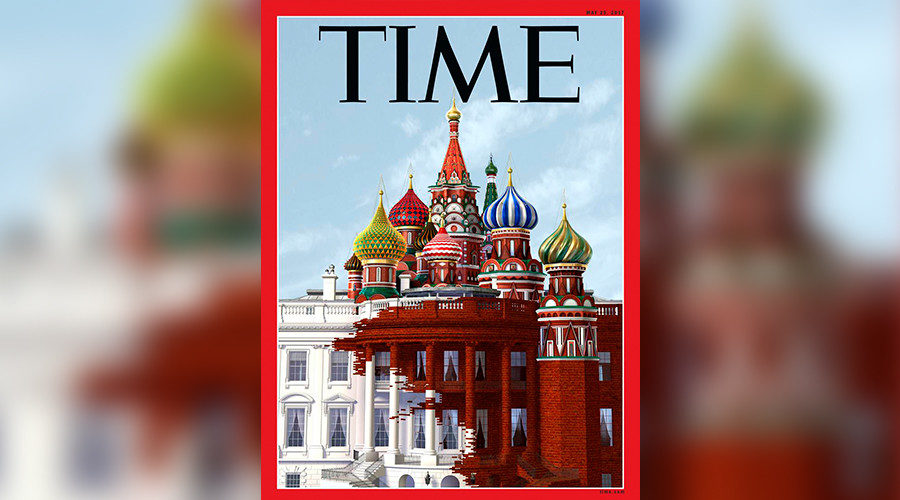
© Screenshot from time.com
Russians have long been dismayed at how foreign media characterizes their homeland. This week's
Time cover gaffe, in which the magazine mistakes a cathedral for the Kremlin, is the latest addition to a collection of confusion.
One of the primary reasons for the creation of RT almost twelve years ago was Russian exasperation at the dreadful Western press coverage of this country - a problem caused by a reliance on poorly trained correspondents in Moscow and willful ignorance from news desks back home. Not to mention a sort of hive mentality where individual outlets and reporters present stereotype as fact.
This sad state of affairs has produced many low points, from 'experts' helping inspire
rumors of Vladimir Putin's death, to makey-uppy
pieces on what he allegedly eats for breakfast. We've also had hacks suggest Russia is about to implode or take over the world, often in the same week. That said, I don't recall anything as dumb as what
Time magazine has pulled off on the cover of its latest edition.
You've probably seen the "artwork" by now. It shows the White House being consumed by Moscow's Saint Basil's Cathedral, a landmark Church on Red Square - an image which suggests Time is trying to portray how the Russian Orthodox Church has taken over the US presidency.Except this, evidently, isn't the publication's intention. Because it's clear they wanted to illustrate the Kremlin, not a house of the holy, dominating the US President's residence. And this is certainly how the intention has been perceived by American media figures and organizations, such as NBC Senior Editor Bradd Jaffy (with his 2,800 Twitter shares) and
USA Today.
To make things worse,
Time author Massimo Calabresi is a former member of the Moscow
"hack pack" - a title western journalists in the Russian capital have chosen for themselves. Thus, you'd think he'd know Putin doesn't work in a church!
Or a mosque, for that matter. Which is how
CNN presented the cover when it described the building's onion domes as "minarets" - presumably because the Orthodox Christian religion isn't scary enough for their agenda.
How to TellAnyway, for the benefit of Massimo and his fellow travelers in the American press, let me explain how you can spot the differences between St. Basil's and the Kremlin. The landmark is also known as the Cathedral of Vasily the Blessed, and was commissioned in 1555 by Ivan the Terrible to commemorate territorial expansion.
St. Basil is situated to the east of the Kremlin, in between Bolshoy Moskvoretskiy bridge and the famous GUM department store. Since 1928, the cathedral has been managed by the State Historical Museum. Church services there were banned by the Stalin regime in 1929, only resuming in 1990, and are now held about once a week.
The actual Moscow Kremlin is the official office of Russia's president, and is on the other side of Red Square. Furthermore, it's not the only 'Kremlin,' which incidentally means 'fortress inside a city,' as there are many others throughout Russia. For instance,
Kazan,
Yaroslavl, and Rostov, among
others, also boast Kremlins of their own.
The capital city version
Time refers to is shaped like an irregular triangle and centers on Cathedral Square. In the northern corner, you can find the Arsenal. The President himself works next door at
The Kremlin Senate, a highly-secured area which is closed to the
public.
By ComparisonTime's faux pas is analogous to using an image of the Washington Monument or the Smithsonian Museum to allude to the White House. Something which would betray laziness and a lack of expertise in any publication.
But, sadly, incompetence, inertia, and ignorance are all too common in Western coverage of Russia - a beat afflicted with too many inept, unskilled, and amateurish hacks. This ineptitude feeds back to newsrooms at home who treat Russian affairs with a sloth and slackness other nations aren't subjected to.It also causes a sensation common to Russians who speak English well and travel abroad - the inability to recognize their own country from how it is described, illustrated, and covered in the West.
There are truly two Russias - the one that approx. 145 million people live in, and the inaccurately rendered version Westerners know through their outrageously prejudiced media.
Reader Comments
to our Newsletter